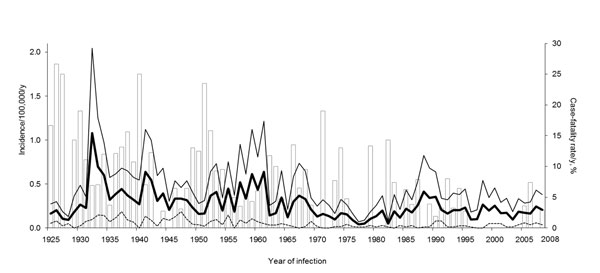Volume 19, Number 3—March 2013
Synopsis
Human Leptospirosis Trends, the Netherlands, 1925–2008
Figure

Figure. . . Incidence rates of leptospirosis, the Netherlands, 1925–2008. White bars indicate case-fatality rate (percentage of deaths/no. of confirmed cases), thick black line indicates total incidence rate (no. cases/100,000 population), thin black line indicates incidence rate among male patients (no. cases in male patients/100,000 male population), and dashed line indicates incidence rate among female patients (no. cases in female patients/100,000 female population). The total population of the Netherlands was 7.3 million in 1925, 8.4 million in 1935, 9.2 million in 1945, 10.7 million in 1955, 12.2 million in 1965, 13.6 million in 1975, 14.5 million in 1985, 15.4 million in 1995, and 16.3 million in 2005.
Page created: February 13, 2013
Page updated: February 13, 2013
Page reviewed: February 13, 2013
The conclusions, findings, and opinions expressed by authors contributing to this journal do not necessarily reflect the official position of the U.S. Department of Health and Human Services, the Public Health Service, the Centers for Disease Control and Prevention, or the authors' affiliated institutions. Use of trade names is for identification only and does not imply endorsement by any of the groups named above.